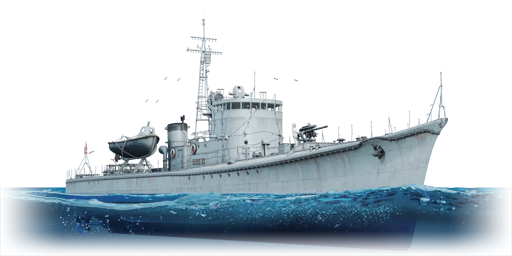

Coastal Fleet
Type K-8 No.13
II
Rank
AB
2.0
RB
2.0
Battle rating
Japan
Research country
Heavy boat
Main role

Premium vehicle
Status
General information
Camouflages
Specification
Armour
Hull
6 mm (steel)
Superstructure
4 mm (steel)
Number of sections
7
Displacement
420 t
Crew
68 persons
Max speed
Forward
30254533 km/h
Backward
1191612 km/h
Primary armament
8 cm/40 3rd Year Type cannon
Ammunition
400 rounds
Reload
basic crew → aces
3.9 → 3 s
Vertical guidance
-7 / 75°
Turret Rotation Speed
Horizontal
119.4119.4 °/s
Vertical
108.5108.5 °/s
| Ammunition | Type | Armor penetration (mm) at a distance: | |||||
|---|---|---|---|---|---|---|---|
| 100 m | 1000 m | 2000 m | 3000 m | 4000 m | 5000 m | ||
| HE | 9 | 8 | 8 | 8 | 8 | 8 | |
| HE-TF | 10 | 8 | 8 | 8 | 8 | 8 | |
Secondary armament
2 × 13.2 mm Type 93 machine gun
Ammunition
3,600 rounds
Belt capacity
30 rounds
Reload
basic crew → aces
2.6 → 2 s
Fire rate
476 shots/min
Vertical guidance
-15 / 80°
Turret Rotation Speed
Horizontal
60516051 °/s
Vertical
7563.87563.8 °/s
| Belt | Belt filling | Armor penetration (mm) at a distance: | |||||
|---|---|---|---|---|---|---|---|
| 10 m | 100 m | 500 m | 1000 m | 1500 m | 2000 m | ||
| T/AP/IAI/AP | 28 | 27 | 24 | 21 | 19 | 17 | |
| IAI/IAI/IAI/T | 25 | 24 | 21 | 18 | 16 | 15 | |
| AP/AP/AP/T | 28 | 27 | 24 | 21 | 19 | 17 | |
Additional armament
Setup 1
7 × Type 95 depth charge
Setup 2
16 × Type 95 depth charge
Setup 3
16 × Type 95 depth charge
7 × Type 95 depth charge
7 × Type 95 depth charge
Economy
Repair cost
AB
834 

RB
581 

Crew training
2,300 

Experts
15,000 

Aces
125 

Research Aces
320,000 

Reward multiplier
AB / RB
 2 x (50 / 45) %
2 x (50 / 45) % 
 2 x 112 %
2 x 112 % 

Premium vehicle
All modifications are unlocked
Seakeeping |
|---|
Unsinkability | |
|---|---|
Firepower | ||
|---|---|---|
Rating by players
You must play more than 3 battles for the last week and more than 10 battles in a vehicle to rate it.
Like:
3
Armor protection:
Not enough ratings
Survivability:
Not enough ratings
Mobility:
Not enough ratings
Armament:
Not enough ratings
Balance:
Not enough ratings
Tips & Tricks
This space is currently empty
Do you know any interesting vehicle features?
Loading...
No articles about this vehicle yet
Become the first author and get rewards!
Write a guide, tell about interesting historical facts, make a tutorial or simply an interesting post.
No more content